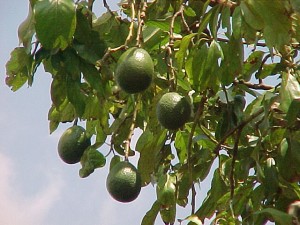Dead Branch on Avocado
 Question from Judy:
Question from Judy:
I live in Orange County and hope you can help me. I was walking around my garden last night when I noticed that a single branch is dying or maybe already dead on the back of my avocado tree where I didn’t notice it before. The green leaves are wilted and some have gone yellow or brown and fallen off. Why would one branch die? I looked around for signs of gophers, but no mounds in sight. We haven’t had a gopher problem since neighbors built all around us…At least there’s one benefit from becoming a concrete jungle! The tree looks healthy otherwise.
What do you think could be attacking my avocado? Water and fertilizer are the same as ever, unchanged for years. We are on old agricultural land and this tree was here before we moved in.
Answer from Pat:
You were wise to look for gophers first since a single branch is often a sign of a critter chewing on feeder roots on one side of a tree. The next thought is borers. Unfortunately, there is now a new pest, a tiny insect smaller than a sesame seed, called the Polyphagous shot borer (PSHB) which is attacking avocado trees as well as native oaks and box elders. This pest was discovered in February in several Orange County and LA neighborhoods. I read about it in the Magazine called “California Agriculture”. According to the article it has a symbiotic relationship with a Fusarium fungus that causes branch die-back. The females bore into trees depositing eggs and the larvae then eat the fungus that arrived with the female insect.
I hope you have a three-legged orchard ladder. If so, climb up and closely inspect the bark of the trunk below and around the affected branch as well as the branch itself for a small round hole or holes that a borer has exited. The hole may be no bigger than a pin head and either look wet or dry and have whitish exude in it. The white or off-white look in the center of the hole can help you find it. If you scrape back the bark you may find galleries and more tiny holes. If you find these signs, first make the phone calls and contacts recommended below and then cut off the affected branch as soon as possible and hope that the disease did not penetrate the rest of the tree. If you cut off the branch early enough, you can actually save the tree. (Make the cut just outside the branch collar, don’t cut it off flush since that prevents the cut from healing.) If I were you I would cut off the branch anyway, whether or not you find the hole. (Don’t move the infected wood since this would spread the pest.)
Even before cutting off the affected branch, if you suspect that PSHB has attacked your tree, please phone your County Agricultural Extension immediately and tell the Master Gardeners or the Farm Advisor about the problem: 714/ 708-1646. Or email them: hotline@uccemg.com . Alternatively, email or phone UC Riverside’s Cooperative Extension plant pathologist, Akif Eslalen: akif.eskalen@ucr.edu or 951/827-3499.

